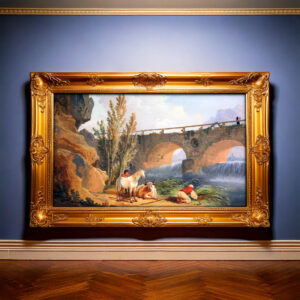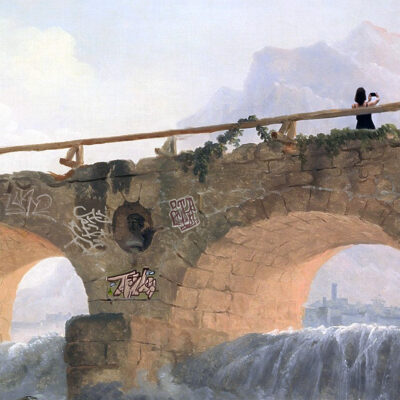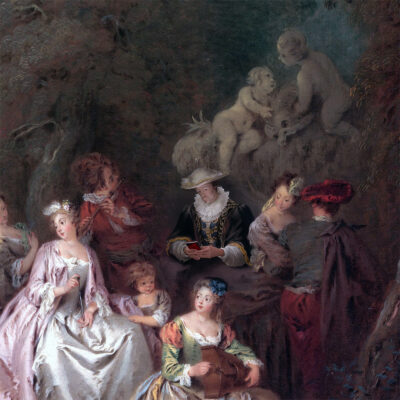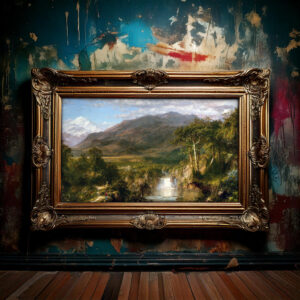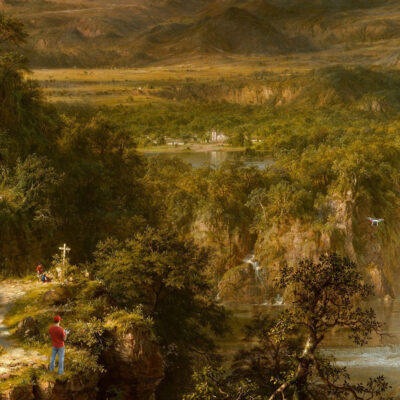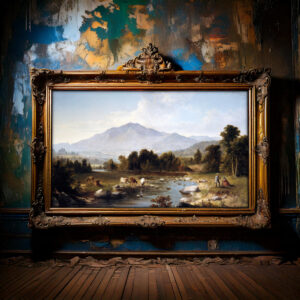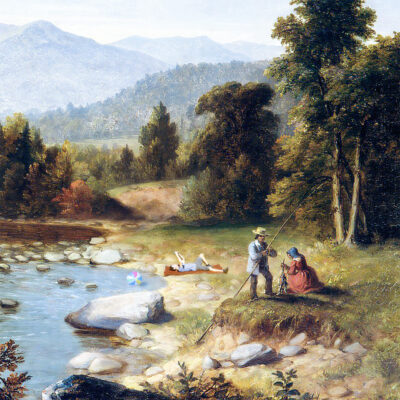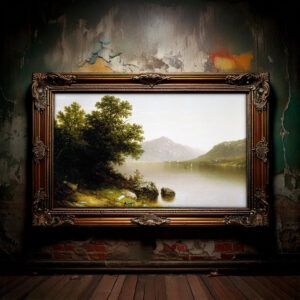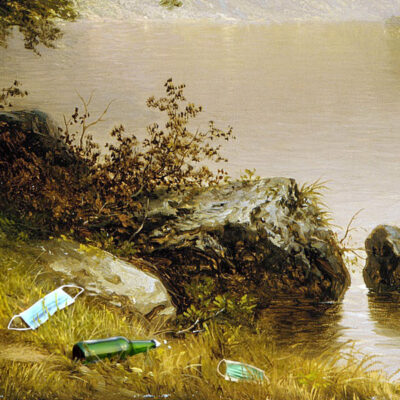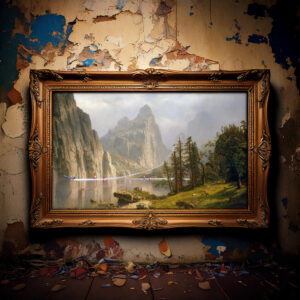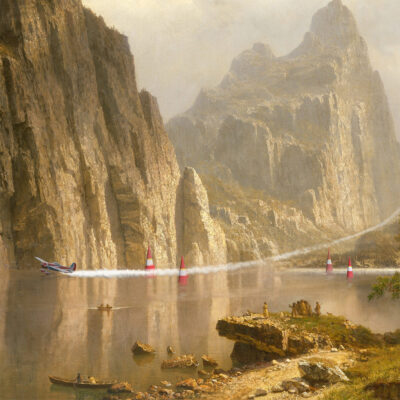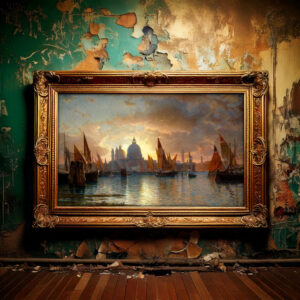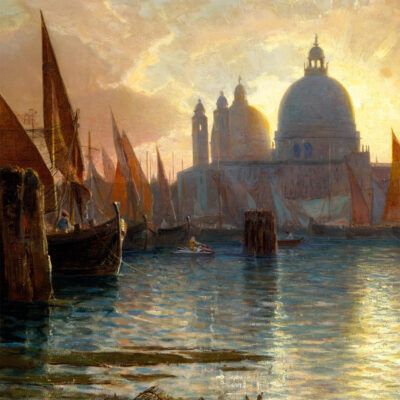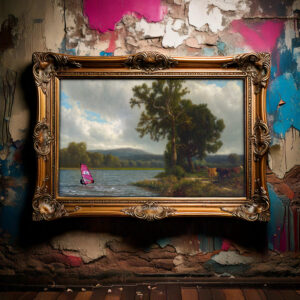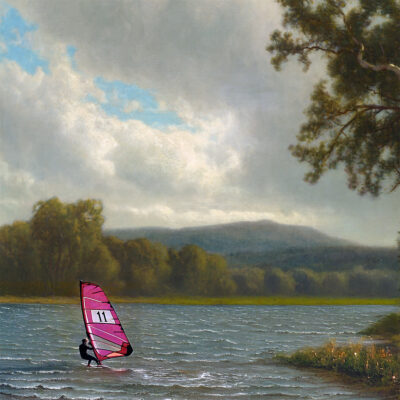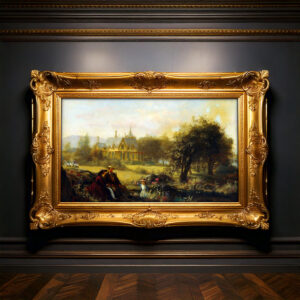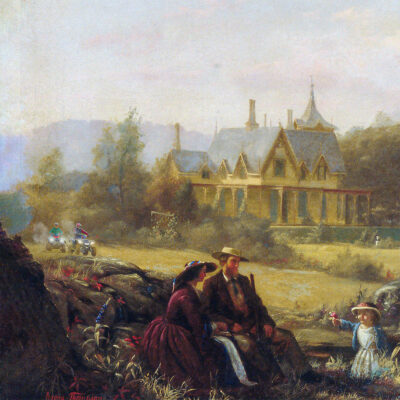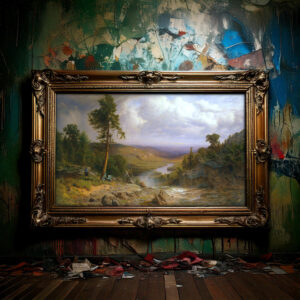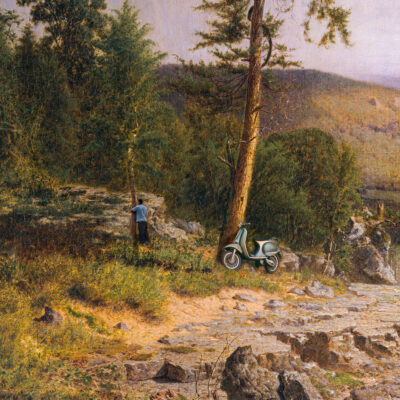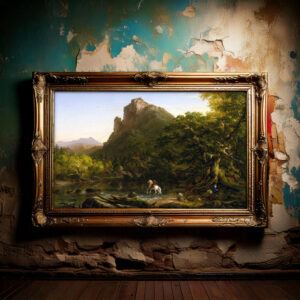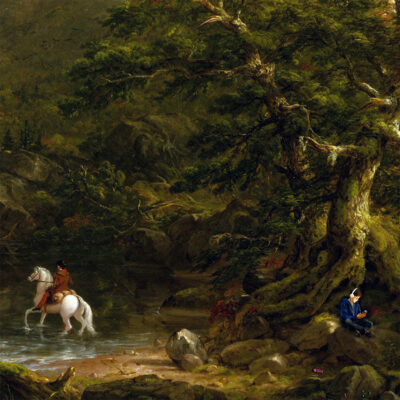Toont alle 11 resultaten
Filters-
Bridge over a Cascade
Dit product heeft meerdere variaties. Deze optie kan gekozen worden op de productpagina€ 299,00Bridge over a Cascade
Hubert Robert | year unknown
Originally painted by Hubert Robert in the late 18th century, Bridge over a Cascade captured the harmony between classical architecture and the sublime power of nature. Intended as an overdoor piece for an opulent Parisian interior, the painting was a quiet celebration of timeless beauty; of cascading waters, weathered stone, and tranquil reflection.
In this reimagined version, the serenity of Robert’s romantic landscape is punctured by the unmistakable marks of modern life. The ancient bridge, once a symbol of connection and continuity, now bears the fluorescent scrawl of graffiti; a silent rebellion, or perhaps a desperate need to be seen. At its center stands a woman, not pausing to take in the grandeur of the cascade below, but absorbed in capturing herself against it. Her back is turned to nature; her focus filtered through the lens of her smartphone.
This intervention is not a mere visual twist; it is a meditation on disconnection in the age of hyperconnection. The piece contrasts the enduring beauty of the natural world with the fleeting noise of digital culture. It asks: What have we brought to these places we once revered? Are we witnessing the world; or simply performing in front of it?
-
Concert Champêtre
Dit product heeft meerdere variaties. Deze optie kan gekozen worden op de productpagina€ 299,00Concert Champêtre
Jean-Baptiste Joseph Pater | ca. 1734
In Concert Champêtre, Jean-Baptiste Joseph Pater invites us into a world of aristocratic leisure; where music, flirtation, and pastoral fantasy converge in a carefully staged performance of harmony. Elegantly dressed figures lounge beneath trees, their powdered wigs and silken garments blending into the soft hues of a dreamlike countryside. It is a scene of curated delight; a moment suspended in grace.
But now, the illusion is broken. At the heart of this reimagined fête galante stands a lone figure, dressed in the same ornate style, yet unmistakably out of place. His powdered hand clutches a glowing mobile phone. His gaze is fixed, not on the lute player or the woman beside him, but on the small screen that pulls him inward and elsewhere. Around him, a few faces turn; not in admiration, but in subtle dismay. His detachment is palpable. He is among them, but not with them.
This quiet fracture within the painting speaks volumes. It confronts the dissonance between communal presence and digital absence; between the cultivated art of being together and the compulsive pull of always being somewhere else. It asks, in its own baroque whisper: have we brought our distractions even into paradise? Or has our need for connection become the very thing that disconnects us?
-
Heart of the Andes
Dit product heeft meerdere variaties. Deze optie kan gekozen worden op de productpagina€ 299,00Heart of the Andes
Frederic Church | 1859
In this altered vision of The Heart of the Andes, a quiet yet jarring intrusion reshapes the harmony Church so meticulously constructed. Perched just above the cliff’s edge, a modern man stands with a remote control in hand, piloting a white drone through the valley below. His presence, though physically small against the vastness of the landscape, disrupts the painting’s balance in a profound way. The drone buzzes through the air, not in reverence of the place, but in pursuit of a spectacle; his own. The man isn’t exploring nature, he’s consuming it.
Church’s original canvas speaks to awe, humility, and the sanctity of wild spaces. The addition of this drone operator casts a stark contrast: where once the viewer was encouraged to lose themselves in the sublime, they’re now reminded of how often we try to possess the moment instead. The drone becomes a symbol of entitlement; the need to capture, control, and curate, even in spaces meant for silence and reflection. It’s a commentary not just on technology, but on attitude; of how easily reverence is replaced by convenience, and wonder by self-interest.
What once was a hymn to interconnected life now carries an uneasy tension: the clash between reverence and interference; between the sacred and the selfish.
-
High Point: Shandaken Mountains
Dit product heeft meerdere variaties. Deze optie kan gekozen worden op de productpagina€ 299,00High Point: Shandaken Mountains
Asher Brown Durand | 1853
In this reimagined scene, the natural beauty of the landscape remains intact—gentle water, sunlit skies, and the stillness of a remote lake framed by mountains or trees. Yet at its center lies a quiet but telling disruption: a man sprawled on a towel, seemingly at ease, but utterly absorbed by the glow of his phone. His beach ball floats adrift on the lake, unnoticed, slowly drifting away like a symbol of lost attention.
The contrast between environment and behavior is striking. This is a place once painted to evoke awe, reflection, or peace; now it hosts a figure physically present but mentally elsewhere. His posture speaks of leisure, but the scene hints at a kind of absence—nature’s invitation is ignored, its rhythms drowned by a digital feed. The beach towel, inflatable ball, and casual sprawl might suggest escape or freedom, yet what unfolds is a subtle portrait of disengagement.
Rather than condemning, the image invites reflection. It asks how often we do the same—bringing our distractions with us even to the most tranquil settings. The man is not villainous, just familiar. In a world of constant connection, we risk forgetting how to simply be where we are.
-
Lake George
Dit product heeft meerdere variaties. Deze optie kan gekozen worden op de productpagina€ 299,00Lake George
John William Casilear| ca. 1857
John William Casilear’s Lake George embodies the serene idealism of 19th-century American landscape painting; a world where nature is pristine, eternal, and untouched by human vice. His tranquil vision of the lake, framed by still waters and soft hills, speaks to a time when the natural world was held as something sacred; worthy of awe, preservation, and contemplation.
In this reimagined version, that stillness is broken not by movement or sound, but by remnants of a very recent history. Mouth masks, now discarded and partially submerged in the riverbed, float beside a green beer bottle. Both artifacts are small in scale but immense in implication. These objects, once symbols of caution and excess respectively, now lie forgotten, as carelessly tossed aside as the responsibilities they once represented.
This subtle intrusion transforms the image into a meditation on human behavior during crisis. The masks, once ubiquitous and essential, now become waste; the beer bottle whispers of clandestine parties held in defiance of public health. Together, they mark the collision between duty and desire, knowledge and neglect. The painting is no longer just a scene of natural beauty; it becomes a mirror, quietly asking what traces we leave behind and what they say about us.
-
Merced River, Yosemite Valley
Dit product heeft meerdere variaties. Deze optie kan gekozen worden op de productpagina€ 299,00Merced River, Yosemite Valley
Albert Bierstadt | ca. 1866
In 1863, Albert Bierstadt embarked on a journey to the American West, capturing its vast and untamed landscapes with the romanticism and grandeur that defined his legacy. Inspired by early photographs of Yosemite Valley, he sought to preserve its breathtaking beauty on canvas, portraying a world already on the cusp of change. His work transformed the valley into something almost mythical; untouched, eternal, and sublime.
But history moves forward. In this reimagined piece, the tranquility of Bierstadt’s Yosemite is disrupted by a jarring modern presence: a Red Bull racing plane slicing through the valley, maneuvering between inflatable pylons. This collision of eras invites reflection. What have we done with the landscapes once held sacred? Have we preserved their essence, or merely repurposed them for spectacle?
The peaks that once symbolized nature’s majesty now serve as the dramatic stage for a fleeting moment of modern thrill. The plane’s trail marks the sky with a symbol of dominance, while the pylons inject a visual of corporate culture into a setting once defined by wilderness. The Indigenous figures who once inhabited this land are gone; their absence echoes louder than the roar of the engine.
This artwork is more than a surreal clash. It is a layered conversation between past and present; a provocation to the viewer. Do we still revere the natural world, or have we simply found more spectacular ways to consume it?
-
Santa Maria della Salute, Sunset
Dit product heeft meerdere variaties. Deze optie kan gekozen worden op de productpagina€ 299,00Santa Maria della Salute, Sunset
William Stanley Haseltine| ca. 1870
William Stanley Haseltine’s Santa Maria della Salute, Sunset captures the quiet grandeur of Venice at dusk. The golden light softens the outlines of the iconic church, casting reflections across the water and inviting a meditative pause. Known for his clarity of detail and reverence for historical beauty, Haseltine portrays Venice not only as a place, but as a symbol of enduring culture and elegance.
Yet within this serene vision, a modern disruption emerges. In the shaded background, almost hidden from the warm glow of sunset, sits a blonde girl astride a jet ski. She wears a bright swim vest and moves slowly through the still water, constrained by harbour regulations. Her presence is unmistakably modern; her posture casual, her attention fixed not on the architecture or the sky, but on reaching open waters where speed and noise are permitted.
This quiet intrusion reframes the scene. The contrast between timeless stillness and fleeting distraction speaks volumes. It raises questions about how we engage with heritage, with beauty, and with the places we visit. Are we observers or consumers? Do we come to connect or to conquer? The girl’s journey becomes a symbol, not just of leisure, but of how modern life often brushes past reverence in pursuit of sensation.
-
Scene at Napanoch
Dit product heeft meerdere variaties. Deze optie kan gekozen worden op de productpagina€ 299,00Scene at Napanoch
William Hart | 1883
Scene at Napanoch by William Hart captures a moment of serene stillness along a quiet river in the Catskills. Painted in the spirit of the Hudson River School, the work radiates a gentle reverence for nature: golden light, hushed water, and rolling hills framed by soft foliage. It is a vision of calm, unhurried life; a world in balance with itself.
That balance is disrupted by a lone windsurfer, cutting through the scene in search of speed and sensation. His brightly colored sail catches the light, but not the spirit of the painting. While the landscape whispers stillness, he moves with restless energy. Even the cows in the field appear to exchange glances of disbelief, unsettled by the intrusion.
This intervention raises a quieter, more ironic tension than some others in the series. It is not about noise or disregard, but about tempo; the rush for stimulation in spaces meant for reflection. The contrast is jarring not because of spectacle, but because it reminds us how even our leisure is now shaped by the pursuit of momentum. In this context, the painting becomes a meditation on the loss of stillness itself.
-
Summer Flowers
Dit product heeft meerdere variaties. Deze optie kan gekozen worden op de productpagina€ 299,00Summer Flowers
Jerome B. Thompson | 1859
In this reimagining of Summer Flowers, the quiet charm of Jerome B. Thompson’s domestic idyll is disrupted. What was once a celebration of stillness and nature’s gentle rhythms now bears the signs of modern disturbance. Two men on loud quad bikes race recklessly through the garden paths, their tires kicking up dust that settles on once-pristine flowerbeds. The roar of engines cuts sharply through the pastoral calm, turning a peaceful setting into a noisy arena.
Nearby, a young family stands together. The parents watch their daughter with quiet admiration as she gently picks flowers, unaware of the disruption closing in. They share a moment of connection and appreciation for the natural beauty around them. But that fragile peace feels increasingly at odds with the intrusion nearby; their expressions flicker between joy and concern as the noise grows louder.
This altered scene invites reflection on how we inhabit shared spaces. Do we still know how to move through the world with care? When thrill and speed overpower presence and attention, what is lost? The clash between old and new is more than visual; it is a question of values. What kind of world are we choosing to cultivate, and for whom?
-
Tennessee
Dit product heeft meerdere variaties. Deze optie kan gekozen worden op de productpagina€ 299,00Tennessee
Alexander Helwig Wyant | 1866
In this tranquil landscape by Alexander Helwig Wyant, the serene forest radiates stillness and timeless beauty. The soft diffusion of light through the trees, the gentle contours of the terrain, and the quiet solitude evoke a moment of pause in nature’s embrace. Wyant’s delicate handling of light and atmosphere invites a contemplative experience, where the viewer is encouraged to linger in silence.
Yet that stillness is subtly fractured. A scooter leans awkwardly against one of the trees, its presence foreign in this otherwise untouched setting. Just beyond, a man stands with his back turned, having rushed behind a tree to relieve himself. His intrusion is momentary, yet its impact lingers. It draws attention not just to the act itself, but to a broader theme of disregard—an impulsive prioritization of personal convenience over reverence for the environment.
This altered scene reflects a tension between presence and thoughtlessness, between immersion in nature and the habits we bring from modern life. The artwork becomes a quiet commentary on how easily we break the spell of serenity and how quickly the sacred can be made mundane.
-
The Mountain Ford
Dit product heeft meerdere variaties. Deze optie kan gekozen worden op de productpagina€ 299,00The Mountain Ford
Thomas Cole | 1846
In this altered version of The Mountain Ford by Thomas Cole, a serene 19th-century wilderness is disrupted by a subtle but telling presence. While the central figures traverse the river on horseback, unaware, a lone boy sits off to the side of the composition—unaccompanied and absorbed by the cold glow of a handheld screen.
He is out of place yet entirely believable. His small figure is hunched, eyes fixed downward, disconnected from the world around him. An empty soda can lies at his feet, casually discarded and unnoticed, much like the scene before him. A knight on horseback rides past just a few meters away, yet the boy remains oblivious, unmoved by the spectacle or setting.
This quiet intrusion offers a layered commentary on our fractured relationship with presence and place. Cole’s original vision invited viewers into a harmonious dialogue between humanity and nature; this version confronts the viewer with solitude and detachment. In an age of constant digital stimulation, even the most majestic or mythical moments risk going unseen—not because they are hidden, but because we are no longer looking.

